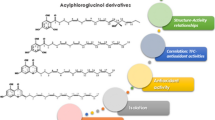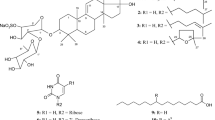Abstract
A new glyceroglycolipid, ishigoside (1, 2-di-O-palmitoyl-3-O-(6-deoxy-6-amino)-α-D-glucopyranosyl-glycerol, 1), along with two known compounds were isolated from the brown alga Ishige okamurae. The structure of the new compound was determined on the basis of spectroscopic analysis, including 1D and 2D NMR, MS techniques and chemical methods. Moreover, direct free radical scavenging activities of ishigoside were investigated by electron spin resonance spectrometry (ESR) technique. The results suggested that ishigoside was a potential free-radical scavenger against DPPH, hydroxyl, alkyl, and superoxide radicals with the EC50 of 31.2, 16.7, 22.7, and 26.8 μM, respectively.
Similar content being viewed by others
References
Squadrito, G.L. and W. A. Pryor (1998) Oxidative chemistry of nitric oxide: the roles of superoxide, peroxynitrite, and carbon dioxide. Free Radic. Biol. Med. 25: 392–403.
Halliwell, B. (1994) Free radicals, antioxidants, and human disease: curiosity, cause, or consequence? Lancent 344: 721–724.
Moskovitz, J., M. B. Yim, and P. B. Chock (2002) Free radicals and disease. Arch. Biochem. Biophys. 397: 354–359.
Stohs, S. J. (1995) The role of free radicals in toxicity and disease. J. Basic Clin. Physiol. Pharmacol. 6: 205–228.
Castro, L. and B. A. Freeman (2001) Reactive oxygen species in human health and disease. Nutrition 17: 161–165.
Choi, D. B., S. S. Park, J. L. Ding, and W. S. Cha (2007) Effects of Fomitopsis pinicola extracts on antioxidant and antitumor activities. Biotechnol. Bioprocess Eng. 12: 516–524.
Koga, T., K. Moro, K. Nakamori, J. Yamakoshi, H. Hosoyama, S. Kataoka, and T. Ariga (1999) Increase of antioxidative potential of rat plasma by oral administration of proanthocyanidin-rich extract from grape seeds. J. Agric. Food Chem. 47: 1892–1897.
Kang, K. S., I. D. Kim, R. H. Kwon, and B. J. Ha (2008) Undaria pinnatifida fucoidan extract protects against CCl4-induced oxidative stress. Biotechnol. Bioprocess Eng. 13: 168–173.
Kim, J. S., Y. H. Kim, Y. W. Seo, and S. Park (2007) Quorum sensing inhibitors from the red alga, Ahnfeltiopsis flabelliformis. Biotechnol. Bioprocess Eng. 12:308–311.
Lee, H. J., Y. A. Kim, J. W. Ahn, H. J. Na, H. M. Kim, and Y. W. Seo (2006) Screening of Korean marine plants for their inhibitory effect on histamine release from RPMC in vitro. Biotechnol. Bioprocess Eng. 11:80–83.
Cho, J. Y., J. S. Choi, S. E. Kang, J. K. Kim, H. W. Shin, and Y. K. Hong (2005) Isolation of antifouling active pyroglutamic acid, triethyl citrate and di-n-octylphthalate from the brown seaweed Ishige okamurae. J. Appl. Phycol. 17: 431–435.
Tang, H. F., Y. H. Yi, X. S. Yao, Q. Z. Xu, T. S. Lv, and S. Y. Zhang (2002) Sterol constituents from marine brown alga Ishige okamurae. Chin. J. Mar. Drugs 21: 1–4.
Tang, H. F., Y. H. Yi, X. S. Yao, S. Y. Zhang, Q. Z. Xu, and S. L. Mao (2003) Studies on chemical constituents from marine brown alga Ishige okamurae (II). Chin. J. Mar. Drugs 22: 8–12.
Tang, H. F., Y. H. Yi, X. S. Yao, J. H. Wu, S. Y. Zhang, and Q. Z. Xu (2002) Studies on chemical constituents from marine brown alga Ishige okamurae (III). China J. Chin. Mater. Med. 27: 269–273.
Toume, K., M. Miyata, K. Egawa, K. Nose, M. Hayashi, K. Komiyama, and M. Ishibashi (2004) Isolation of diphlorethohydroxycarmalol from a brown alga Ishige okamurae. Nat. Med. 58: 79–80.
Nanjo, F., K. Goto, R. Seto, M. Suzuki, M. Sakai, and Y. Hara (1996) Scavenging effects of tea catechins and their derivatives on 1,1- diphenyl-2-picrylhydrazyl radical. Free Radic. Biol. Med. 21: 895–902.
Rosen, G. M. and E. J. Rauckman (1984) Spin trapping of superoxide andhydroxyl radicals. pp. 198–209. In: L. Packer (eds.). Methods in Enzymology. Academic Press, Orlando, FL, USA.
Hiramoto, K., H. Johkoh, K. Sako, and K. Kikugawa (1993) DNA breaking activity of the carbon-centered radical generated from 2, 2′-azobis(2-amidinopropane) hydrochloride (AAPH). Free Radic. Res. Commun. 19:323–332.
Guo, Q., B. Zhao, S. Shen, J. Hou, J. Hu, and W. Xin (1999) ESR study on the structure-antioxidant activity relationship of tea catechins and their epimers. Biochim. Biophys. Acta 1427: 13–23.
Lee, C. K., P. H. Lee, and Y. H. Kuo (2001) The chemical constituents from the aril of Cassia fistula L. J. Chin. Chem. Soc. 48: 1053–1058.
Yamaoka, N., T. Usui, H. Sugiyama, and S. Seto (1974) 13C NMR spectra of some aminosugars and sugarantibiotics, neomycin and kanamycin. Chem. Pharm. Bull. 22: 2196–2200.
Andersen, R. J. and O. Taglialatela-Scafati (2005) Avrainvilloside, a 6-deoxy-6-aminoglucoglycerolipid from the green alga Avrainvillea nigricans. J. Nat. Prod. 68:1428–1430.
Schwender, J., M. Seemann, H. K. Lichtenthaler, and M. Rohmer (1996) Biosynthesis of isoprenoids (carotenoids, sterols, prenyl side-chains of chlorophylls and plastoquinone) via a novel pyruvate/glyceraldehyde 3-phosphate non-mevalonate pathway in the green alga Scenedesmus obliquus. Biochem. J. 316: 73–80.
Kim, J. D. and C. G. Lee (2005) Systemic optimization of microalgae for bioactive compound production. Biotechnol. Bioprocess Eng. 10: 418–424.
Khotimchenko, S. V. (2002) Distribution of glycerolglycolipids in marine algae and grasses. Chem. Nat. Comp. 38: 223–229.
Zhou, B. N., S. Tang, R. K. Johnson, M. P. Mattern, J. S. Lazo, E. R. Sharlow, K. Harich, and D. G. I. Kingston (2005) New glycolipid inhibitors of Myt1 kinase. Tetrahedron 61: 883–887.
Sachindra, N. M., E. Sato, H. Maeda, M. Hosokawa, Y. Niwano, M. Kohno, and K. Miyashita (2007) Radical scavenging and singlet oxygen quenching activity of marine carotenoid fucoxanthin and its metabolites. J. Agric. Food Chem. 55: 8516–8522.
Antolovich, M., P. D. Prenzler, E. Patsalides, S. McDonald, and K. Robards (2002) Methods for testing antioxidant activity. Analyst 127: 183–198.
Makino, K., T. Hagiwara, and A. Murakami (1991) A mini review: fundamental aspects of spin trapping with DMPO. Radiat. Phys. Chem. 37: 657–665.
Noguchi, N., A. Watanabe, and H. Shi (2000) Diverse functions of antioxidants. Free Radic. Res. 33: 809–817.
Author information
Authors and Affiliations
Corresponding author
Rights and permissions
About this article
Cite this article
Zou, Y., Li, Y., Kim, MM. et al. Ishigoside, a new glyceroglycolipid isolated from the brown alga Ishige okamurae . Biotechnol Bioproc E 14, 20–26 (2009). https://doi.org/10.1007/s12257-008-0131-3
Received:
Accepted:
Published:
Issue Date:
DOI: https://doi.org/10.1007/s12257-008-0131-3




